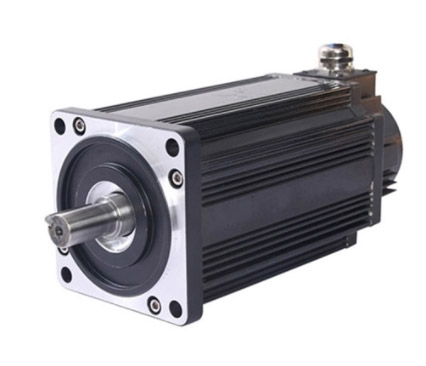3 Ways to Control the Servo Motor
Servo motor is also called execution motor. Its working principle is similar to that of a two-phase asynchronous motor. However, because it is used as an actuator in a CNC machine tool to convert an AC signal into an angular displacement or angular velocity on the shaft, the speed of the rotor speed is required to reflect the phase of the control signal. It does not rotate when there is no control signal.
Since the two windings on the stator are spaced apart by an electrical angle of 90°, if a symmetrical voltage with the same amplitude and a phase difference of 90° electrical angle is applied to the two-phase windings, a circular shape will be generated in the air gap of the motor. Rotating magnetic field. If the amplitude of the two voltages is not equal or the phase is not 90° electrical angle, the generated magnetic field will be an elliptical rotating magnetic field. If the signal applied to the control winding is different, the ellipticity of the generated magnetic field is also different.
The rotor inside the servo motor is a permanent magnet. The U/V/W three-phase electricity controlled by the driver forms an electromagnetic field. The rotor rotates under the action of this magnetic field, and at the same time, the encoder of the motor will feedback signals to the driver. The driver compares the feedback value with the target value to adjust the angle of rotation of the rotor.
Servo motors are often used. It can be used in common industrial and civil occasions that are sensitive to cost. We need to understand some of its basic knowledge, such as control methods and control principles. Only by understanding this knowledge can it be operated correctly. Let's learn how to control the servo motor below.
Servo motors generally have three control modes, namely: Speed control mode, torque control mode and position control mode. Both speed control and torque control are controlled by analog, while position control is controlled by sending pulses.

1. Servo motor speed control
The rotation speed can be controlled by analog input or pulse frequency. When there is outer loop PID control of the upper computer control device, the speed mode can also be used for positioning. However, the position signal of the motor or the position signal of the direct load must be fed back to the upper computer for calculation. Speed mode also supports direct load outer loop detection position signal. At this time, the encoder at the motor shaft end only detects the motor speed, and the position signal is provided by the direct detection device at the final load end. This has the advantage of reducing errors in the intermediate transmission process and increasing the positioning accuracy of the entire system.
2. Servo motor Torque control
The specific method is to set the external output torque of the motor shaft through the input of the external analog quantity or the assignment of the direct address. The specific performance is: For example, if 10V corresponds to 5Nm, when the external analog quantity is set to 5V, the motor shaft output is 2.5Nm. If the motor shaft load is lower than 2.5Nm, the motor rotates in a clockwise direction; when the external load is equal to 2.5Nm, the motor does not rotate; when the external load is greater than 2.5Nm, the motor rotates in an anticlockwise direction. The setting torque can be changed by instantly changing the analog setting. It can also be achieved by changing the value of the corresponding address through communication. Its application is mainly in winding and unwinding devices that have strict requirements on the force of the material, such as winding devices or fiber optic equipment.
3. Servo motor position control
The position control method generally determines the rotation speed by the frequency of externally input pulses, and determines the rotation angle by the number of pulses. There are also some servo drives that can directly assign speed and displacement through communication. Because the position mode can have very strict control on speed and position, it is generally used in positioning devices, such as CNC machine tools, printing machinery and so on.

